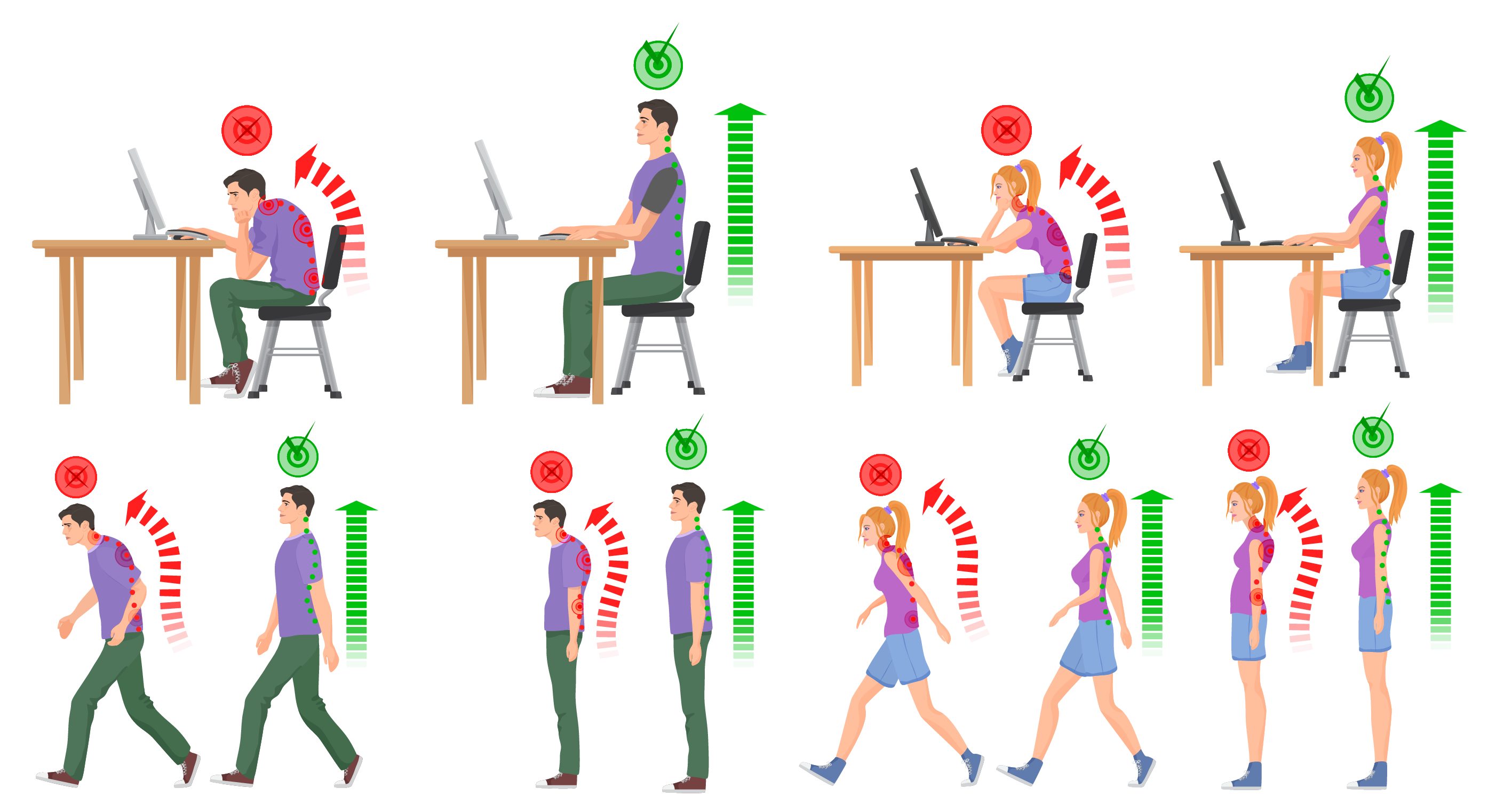Computers have definitely led to an increase in workplace efficiency. However, they have also had a major impact on American workers’ long-term health and well being. American office workers are some of the most focused and hardest working employees in the world but the long sedentary hours are taking a toll. Even as future advancements in technology will allow us to create and accomplish more, these same technologies are making us stay sedentary, creating weakness and dysfunction to the important postural muscles of the body.
Human beings are hardwired to achieve a stable, upright posture by the age of four years. At that age our body develops the curvatures of the spine to maintain an upright posture. Due to television, texting, chairs, desks, driving in cars, and sedentary work the thoracic spine slips into a greater kyphosis.
The kyphosis of the thoracic spine is an increased rounding of spine’s natural curve. As the curvature of the thoracic spine slips into poorer posture the other curves have to compensate for it to maintain an upright position. Therefore, any alteration within your thoracic spine will lead to alterations in the back/pelvis and neck/head posture which is likely to increase the incidence of pain.
The curvatures of the spine influence each other in dysfunction as well as in rehabilitation. It has been shown that a significant association exists between a reduction in mobility of the thoracic spine and the presence of patient-reported complaints associated with neck and low back pain. This is why a chiropractic adjustment of the thoracic spine is critical to maintain a healthy neck and low back.
Thoracic dysfunction can also lead to overuse of the auxiliary muscles of respiration such as the neck and shoulder muscles. This causes inhibition and weakness of the natural muscle of respiration, that being the diaphragm. Not only does this cause a drop in respiratory function but this can also be a leading cause headaches and shoulder pain.
Hyperkyphosis of the thoracic spine is associated with shortness of breath and ventilatory dysfunction, which is a source of fatigue in the body. This reduced oxygen flow to the body and brain is most common in the seated position similar to those assumed by the sedentary worker. Is it any wonder why so many American office workers today are so tired?
Thoracic spine dysfunction is very much a silent killer, in that it is a common source of muscle imbalance, trigger points, joint dysfunction and faulty movement patterns all being asymptomatic. We simply don’t feel pain often in these areas. The most common sites affected by thoracic dysfunction are the neck, TMJ, shoulder, arm and even lower back regions. This is also a main reason why treatment for various aches and pains in the above mentioned areas provides no resolution. Treatments aimed at the site of the symptoms are bound to fail.
 If you are dealing with pain in these areas, do not stretch the painful muscles. These muscles are most often already being stretched by the increased kyphosis thus creating pain. Try putting ice on the irritated muscles or using Biofreeze to reduce the painful symptoms in the affected areas while striving to reduce the thoracic dysfunction. (You can pick up Biofreeze on sale at our Roanoke, Virginia chiropractic office through July 20!)
If you are dealing with pain in these areas, do not stretch the painful muscles. These muscles are most often already being stretched by the increased kyphosis thus creating pain. Try putting ice on the irritated muscles or using Biofreeze to reduce the painful symptoms in the affected areas while striving to reduce the thoracic dysfunction. (You can pick up Biofreeze on sale at our Roanoke, Virginia chiropractic office through July 20!)
When these exist a thoracic spine dysfunction, such as a hyperkyphotic thoracic spine, extension is restricted and a chain effect occurs in the body. This leads to the shoulders rolling forward into a rounded and internally rotated position, I like to call this Grandma/Grandpa posture. This causes shoulder muscles to increase stress on the shoulder joint. This stress reduces mobility in arm elevation and predisposing to mechanical impingement of the rotator cuff muscles and shoulder labrum. This also develops a chin protrusion because of a forward head posture causing hyperextension at the C0-C1 joint leading to the alterations in the function of the TMJ. The protruding chin leads to a decrease in extensibility in mouth opening, which alters the biomechanics of the TMJ increasing stress on the disc.
All of this occurs in your body, unbeknownst to you unless a symptom has developed for you to be mindful of and treat. Your body will continue to do what you ask of it, so when you reach to lift something overhead, instead of extending through the middle of your back, you end up increasing the mobility in your lumbar spine leading to low back symptoms and long term impacts on your lumbar discs.
Rehabilitation of the upright posture is fundamental to optimization of function in the locomotor system. Neurological programs for maintenance of the upright posture are “hard-wired” into the central nervous system. The human brain creates an imprint for how to hold the body up so that so there is no engagement of active thought. In other words, what that means, is that rehabilitation of the thoracic area is of central importance, both biomechanically and neurophysiologically for better posture and health.
Along with your chiropractic adjustments, rehabilitation begins with a few simple exercises.
As we demonstrate in our video, “5 Exercises To Fix Your Head, Neck, and Shoulder Pain,” a few simple exercises performed daily can be the key to improving your posture. In this video we show the Scap Push Up, Bruegger’s Stretch, the Foam Roller Extension, and the Unstable Push Up to reduce your thoracic spine dysfunction. Try performing these exercises daily, and watch the results speak for themselves.
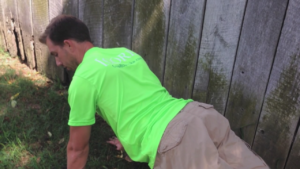 Scap Push Up
Scap Push Up
Start in a push-up position with your elbows locked. The movement of the push-up comes only from moving the scapula together and then apart. The motion of the exercise should be felt only in the thoracic spine not in the arms.
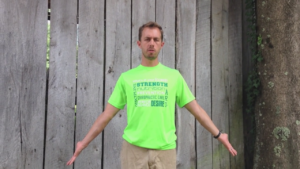 Bruegger’s Stretch
Bruegger’s Stretch
Stand upright and very tall. Roll your thumbs backward rotating your shoulders into a retracted position. From this position breath in and out slowly. Hold for 30 seconds with several breathing cycles.
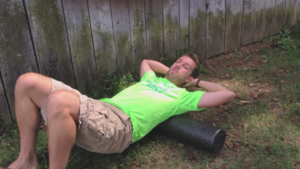 Foam Roller Extension
Foam Roller Extension
Lay on a foam roller perpendicular to the thoracic spine. Lift your hips up off of the floor and roll back and forth over the thoracic spine. Continuing rolling for 30 seconds or more.
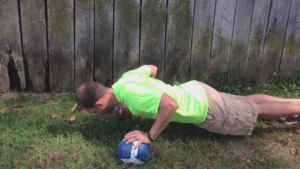 Unstable Push-up
Unstable Push-up
Perform a push-up from off of your feet or knees while your hands are on any unstable surface. You can use miniature basketballs, wobble boards, or a foam roller. Perform as many push-ups as you can.

Daryl C. Rich, D.C., CSCS, DC, ART®

